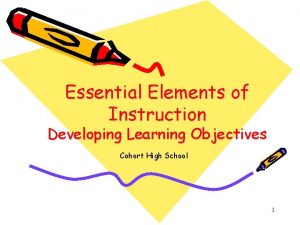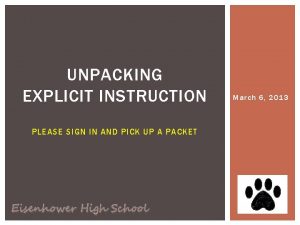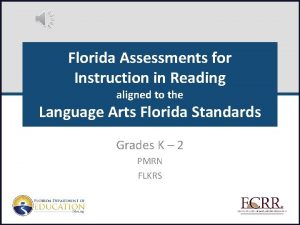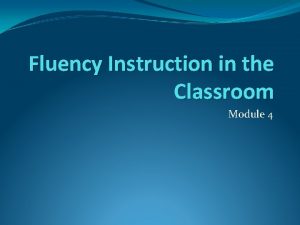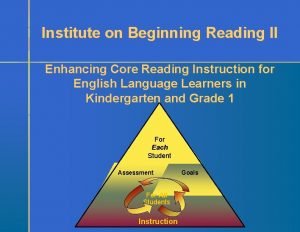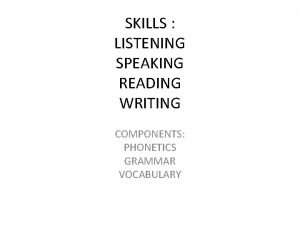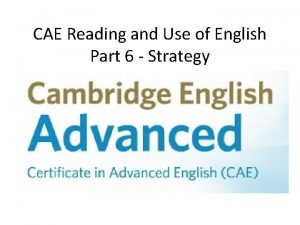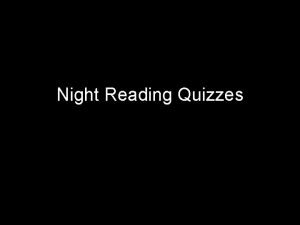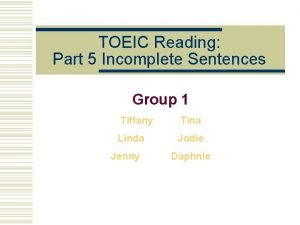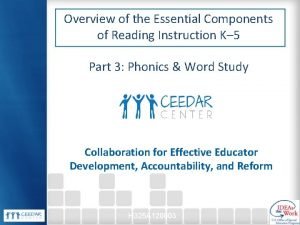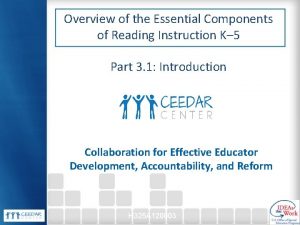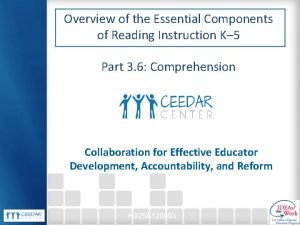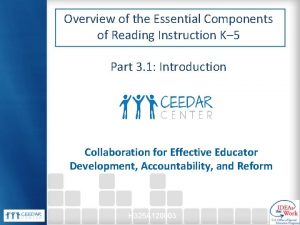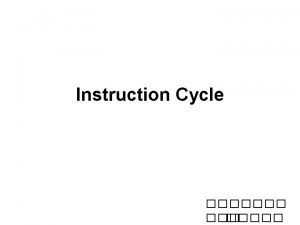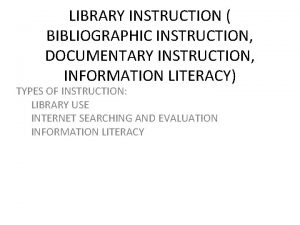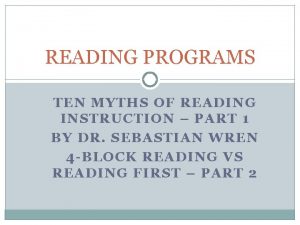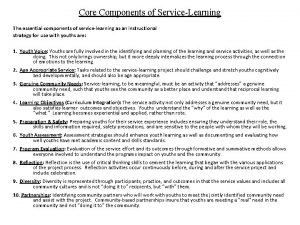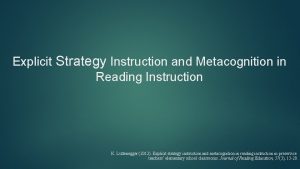Essential Components of Reading Instruction K 5 Part


























- Slides: 26

Essential Components of Reading Instruction K– 5 Part 3. 2: Phonological and Phonemic Awareness

Phonemic Awareness • The ability to hear, identify, and manipulate individual sounds— phonemes—in spoken words. • Part of the phonological awareness umbrella. Al Otaiba, Kosanovich, & Torgesen, 2012; Ehri, 2001; Torgesen & Mathes, 2000; Uhry, 2011

PA begins with listening © 2009 University of Texas System/Texas Education Agency

Phonological Awareness Continuum © 2009 University of Texas System/Texas Education Agency

Another View of the Phonological Awareness Continuum © 2009 University of Texas System/Texas Education Agency

Phonological Awareness Continuum As you watch, note: • Activities for each level. • Phonological awareness in Spanish. • The connection of sounds to letters.

PA Continuum Student has difficulty. . . 1. Blending phonemes into a whole word. 2. Telling which word is different. 3. Identifying medial sound. 4. Substituting individual sounds.

English Phonemes • 26 letters. • 44 phonemes. • 98 phoneme-grapheme associations. Vaughn & Linan-Thompson, 2004

Phonemes © 2009 University of Texas System/Texas Education Agency

Important Points About Phonological Awareness • Ability to blend and segment phonemes predicts reading skills. • Phonological awareness can be taught. • Phonological awareness helps with spelling. • Direct, explicit instruction is essential for students. Brady, 2011; Foorman & Torgesen, 2001

More Points About Phonological Awareness • instruction should be paired with letters as soon as students and segment and blend three phoneme words. • 15 -20 minutes of phonological awareness instruction a day is sufficient for most K-1 students. Ehri et al. , 2001; Ehri & Roberts, 2006; Foorman & Torgesen, 2001

Mouth Pictures • Letters plus mouth pictures illustrating articulation improved learning. • Mouth with closed lips: /b/ /p/ /m/ • Teeth touching lower lip: /f/ /v/ • Mouth open & lips rounded: /o/ Ehri, 2014

Phonological, Phonemic, Phonics • Partner A: phonological awareness and phonics? • Partner B: phonemic awareness and phonological awareness? • Create “elevator” explanation of phonemic awareness.

Common Core State Standards Foundational Skills–Kdg • 2. Demonstrate understanding of spoken words, syllables, and sounds (phonemes). • a. Recognize and produce rhyming words. • b. Count, pronounce, blend, and segment syllables in spoken words. • c. Blend and segment onsets and rimes of single-syllable spoken words. • d. Isolate and pronounce the initial, medial vowel, and final sounds (phonemes) in three-phoneme (consonant-vowel-consonant, or CVC) words. * (This does not include CVCs ending with /l/, /r/, or /x/. ) • e. Add or substitute individual sounds (phonemes) in simple, one-syllable words to make new words.

Common Core State Standards Foundational Skills–Grade 1 • 2. Demonstrate understanding of spoken words, syllables, and sounds (phonemes). • a. Distinguish long from short vowel sounds in spoken single-syllable words. • b. Orally produce single-syllable words by blending sounds (phonemes), including consonant blends. • c. Isolate and pronounce initial, medial vowel, and final sounds (phonemes) in spoken single-syllable words. • d. Segment spoken single-syllable words into their complete sequence of individual sounds (phonemes).

Practice and Application Instructional Sequence • I Do (teacher models) • We Do (teacher and students) • You Do (students)

Say It and Move It Blachman et al. , 2000

Manipulating Phonemes Elision & Substitution

Grab a Group A fun way to practice identifying phonemes after students understand the concept. Remember, this is a listening activity. Always have students repeat the words and orally segment the words.

Phonological Awareness Activity Cards • What concept is addressed? • On the continuum, what concepts should precede the on the card? © 2002 University of Texas System/Texas Education Agency

Phoneme Mapping f a s t c r a sh m e t t r u Adapted from the work of Berninger et al. , 1998; Ehri, 1998; Moats, 2004 ck

Challenges With your partner, discuss the challenges you anticipate some students may have with phonemic awareness. For each challenge, list ways you could scaffold instruction. You have 5 minutes.

More Indicators of Risk Difficulty with inventive or emergent spelling. Difficulty following finger-point reading.

In Action • Partner A: Note what facets of phonological awareness are taught. • Partner B: Note how the teacher reinforces the learning. • All: Note how the teacher differentiates the instruction.

Application Assignment Review the materials at: www. fcrr. org Grades K & 1: Phonemic Awareness Teach the activity to a young student Reflect: What worked? What will I do differently next time? How can I differentiate the instruction?

Assessment 1. Complete the quiz independently. 2. In a small group, discuss your answers and reach a consensus. 3. Submit one quiz with the names of group members.
 Pre reading while reading and post reading activities
Pre reading while reading and post reading activities Characteristics of lipids
Characteristics of lipids Essential elements of instruction
Essential elements of instruction Individualized instruction vs differentiated instruction
Individualized instruction vs differentiated instruction Site:slidetodoc.com
Site:slidetodoc.com Spectrophotometer
Spectrophotometer Components of explicit instruction
Components of explicit instruction What are the essential parts of business letter
What are the essential parts of business letter Florida assessment for instruction in reading
Florida assessment for instruction in reading Fluency oriented reading instruction
Fluency oriented reading instruction Enhanced core reading instruction
Enhanced core reading instruction Dawn reithaug
Dawn reithaug Scarborough reading rope model
Scarborough reading rope model Grammar listening speaking reading writing
Grammar listening speaking reading writing Five components of reading
Five components of reading Part whole model subtraction
Part whole model subtraction Part to part ratio definition
Part to part ratio definition Part part whole
Part part whole Technical description examples
Technical description examples Pouring station in bar
Pouring station in bar The part of a shadow surrounding the darkest part
The part of a shadow surrounding the darkest part Two way anova minitab 17
Two way anova minitab 17 Reading part 6 pet 2020 pdf
Reading part 6 pet 2020 pdf Cae reading part 6
Cae reading part 6 Scotty weems
Scotty weems Night chapter 1-4 quiz
Night chapter 1-4 quiz Incomplete sentences toeic
Incomplete sentences toeic


